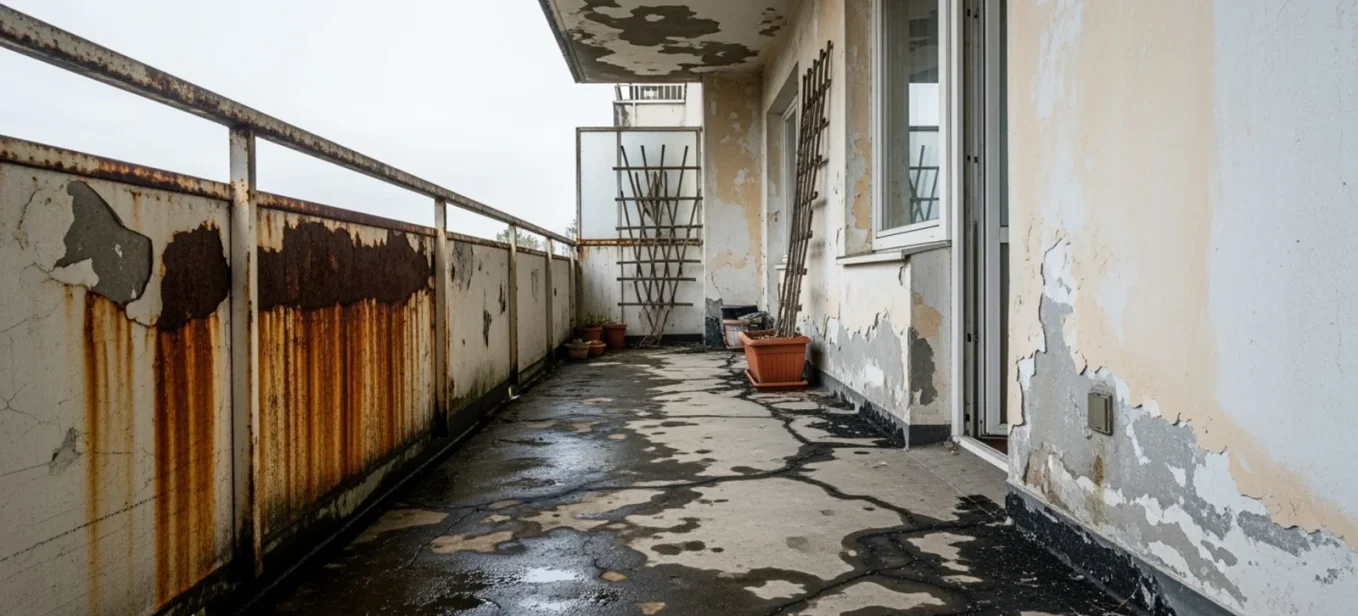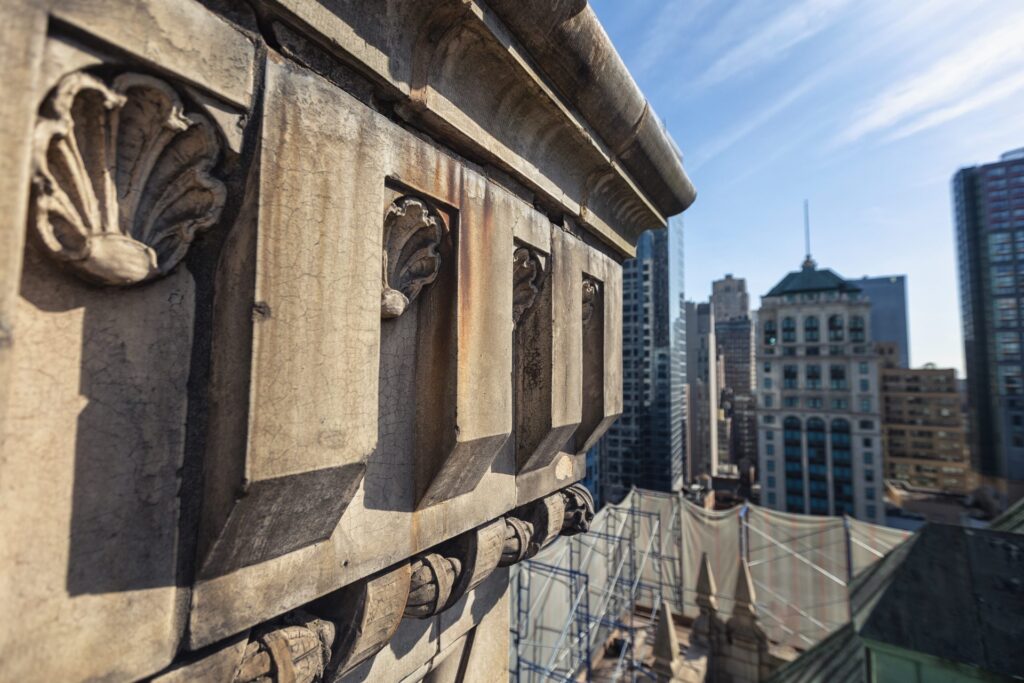
Balcony Waterproofing: Top Techniques and Materials
- By: Nova Construction Team
- Published:
- Updated: December 19, 2025
Waterproofing your balcony is absolutely necessary if you want to protect your building’s structure, appearance, and value.
Balconies face rain, sunlight, and temperature fluctuations all year long. If they aren’t properly waterproofed, they can easily be damaged by water, which leads to problems like weakened structure, rust, mold, and expensive maintenance and repair bills.
Using innovative waterproofing solutions and reliable materials from the beginning is the best solution to stop water from getting in, helping your balcony stay safe, attractive, and useful for many years.
Why You Must Waterproof Your Balcony
Balconies are exterior areas attached to homes or buildings, and they deal with constant weather changes. Because of this, they are more likely to have water issues if they are not well-protected.
Skipping waterproofing can turn into more than a small problem — it can create real dangers and significantly lower the building’s value.
1. Stops Damage to the Structure
The main reason to waterproof balcony surfaces is to prevent long-term structural damage.
When water gets into the layers below the surface, it can harm important parts like wood (causing rot) or the steel bars in concrete (causing rust). Over time, this makes the whole balcony weaker and could even lead to collapse.
A quality waterproofing membrane acts like a strong impermeable barrier that keeps these key parts safe from water and ensures the integrity for years to come.
2. Prevents Moisture and Leaks
Waterproofing solutions don’t just protect the structure — they also keep moisture and leaks away. If water pools or leaks through cracks and seam areas, it can run down to lower floors or inside your home, damaging walls, ceilings, and belongings.
Effective balcony waterproofing systems ensure proper water flow and drainage system functionality so water doesn’t collect or seep in, keeping both the balcony and the rooms below it dry.
3. Helps Surfaces Last Longer
The look of your balcony comes from the materials and finishes, like tiles or wood. Water can crack, stain, or ruin these surfaces, meaning more repairs and higher costs.
The best waterproofing solution creates a continuous barrier that keeps water out so your tiles, paint, or deck boards stay in good shape and preserve their appearance for longer.
4. Reduces Mold and Health Risks
Water leaks can lead to mold, which is ugly and can cause breathing problems, especially for people with allergies or asthma. Proper waterproofing solutions limit moisture, which makes it much harder for mold or mildew to grow, helping keep your living space healthier.
Main Factors That Make Waterproofing Work
Waterproofing a balcony the right way means thinking about some key factors before you start. These include the design, the weather in your area, and the condition of the balcony’s surface to ensure adequate protection.
Balcony Shape and Drainage
How your balcony is built affects how water moves across it. Every balcony needs a slight slope — about 2 percent or 1/4 inch per foot — so water drains away rather than pooling. Gutters, drains, and scuppers must be included and kept clean as part of an effective drainage system.
Balconies with lots of corners, railings, or lighting need more flexible waterproofing solutions so water can always find a clear path to run off and maintain proper water flow.
Weather and Climate
The local weather is very important for determining your waterproofing needs. If you live somewhere with lots of rain, humidity, or freezing and thawing temperature cycles, you’ll need stronger, more durable membrane waterproofing.
In cold areas, water can freeze in cracks, forcing them to grow larger. Hot sun can also wear down some waterproofing materials.
Always choose products made to handle the sunlight, heat, or temperature variations that your balcony will face.
Condition of the Surface
The balcony’s main layer (the “substrate”) should be solid, clean, dry, and without cracks or mold. Any damage must be fixed before installation begins. For instance, any broken spots in concrete should be patched.
If there’s already an old waterproof coating, it usually needs to be fully removed before applying a new waterproofing membrane. Careful inspection makes sure the new system sticks well and does its job.
Steps to Get a Balcony Ready for Waterproofing

Proper preparation is the backbone of a successful waterproofing job. Skipping these steps can cause the new system to fail quickly and cost you time and money.
1. Inspect the Surface
Start by checking the balcony for water damage, stains, soft spots, rust, or mold. Look for cracks, uneven areas, or places where water pools. If you see lots of damage, it might be best to call a building inspector who knows the rules for your area.
Your findings will help you know what has to be fixed or cleaned before starting the application process.
2. Clean and Repair the Base
Next, clean the whole area very well — sweep away all dirt, leaves, and debris. Use a wire brush or special cleaner for stubborn spots.
Strip away any old finishes, paint, or coatings, since they stop new waterproofing materials from sticking. Fix cracks or chips with compatible fillers, and replace or patch any rotten wood.
The aim is to make the surface smooth, strong, and ready so your waterproofing system creates a proper interface and sticks properly.
3. Fix Cracks and Joints
Every crack or joint needs to be filled with the proper sealant (depending on if it’s concrete, wood, etc.). Where the balcony touches the wall or where railings pass through, use extra polyurethane sealants, special fabric reinforcement, or metal flashing to make these areas watertight.
Fix any uneven patches or bad slopes while prepping so the final system directs water away properly and maintains adequate drainage.
Main Waterproofing Techniques for Balconies
There are several common ways to waterproof a balcony. The right method depends on things like the type of balcony and the normal weather where you live.
- Liquid Membranes: Apply a liquid product using a brush or roller. It dries to form a single, flexible layer that fills tiny cracks and can fit around odd shapes. It’s common for balconies with lots of edges or details.
- Sheet/Rolled Membranes: Big sheets of waterproof material (such as PVC, EPDM, or similar) are unrolled over the surface and attached with glue or heat. These resist tearing and are a good choice for larger, flat balconies.
- Cement-Based Coatings: Waterproofing chemicals are mixed into cement and spread over the surface. This is a cost-friendly option that works well on concrete or wood, especially in milder climates. It creates a strong, rigid finish.
- Polyurethane and Hybrid Coatings: These are flexible, glossy coatings that protect against sun, moisture, and minor cracks. Hybrids mix the best properties from several materials for better strength and flexibility.
- Rubberized Asphalt Systems: These membranes provide excellent adhesion and flexibility, making them ideal for areas with significant temperature variations.
Popular Materials for Balcony Waterproofing
| Material Type | Main Benefits | Best For |
|---|---|---|
| Acrylic/Polymer Liquids | Flexible, easy to apply, good UV resistance | Top layers; where sun exposure is high |
| PVC or TPO Sheets | Strong, durable, resistant to punctures and chemicals | Large, flat balconies needing long-term protection |
| Epoxy/Polyurea Coatings | Can handle lots of foot traffic, resists chemicals/abrasion | Busy areas or where fast curing is needed |
| Sealants & Tapes | Seal joints & corners, flexible | Detailing around drains, rails, and edges |
How Nova Construction Can Help You
At Nova Construction, we understand that every balcony has unique waterproofing needs, and we’re committed to providing the best waterproofing solution for your specific situation.
Our experienced team specializes in both new construction and renovation projects, ensuring that whether you have a single balcony or a number of balconies in a multi-family building, we deliver custom solutions that preserve your investment.
- Expert Installation and Application: Our skilled professionals ensure proper installation of all types of balcony waterproofing systems, from liquid waterproofing applications to sheet membrane installations. We use only compatible, high-quality materials and follow industry best practices to ensure adequate coverage and long-lasting results.
- Comprehensive Waterproofing Solutions: We offer innovative membrane waterproofing options including self-adhesive systems, rubberized asphalt applications, water-based coatings, and eco-friendly alternatives. Our team can modify existing systems or design custom solutions that work with your building’s specific requirements and local temperature conditions.
- Quality Materials and Labor: We work with trusted manufacturers to provide impermeable barriers using top-quality materials like polyethylene sheets, silicone-based sealants, fabric reinforcements, and polyurethane sealants. Our experienced labor team ensures continuous coverage and proper seam sealing for maximum protection.
- Drainage System Expertise: Proper water flow is crucial for any waterproofing system. We design and install effective drainage systems that work seamlessly with your waterproofing membrane to ensure water moves away from your structure and doesn’t compromise the exterior surfaces.
- Cost-Effective Long-Term Value: While we provide competitive pricing, our focus is on delivering cost-effective solutions that significantly reduce your maintenance and repair bills over time. We help you avoid long-term structural damage by ensuring your waterproofing maintains its integrity for years to come.
- Ongoing Support: Beyond installation, we provide guidance on proper maintenance to extend the life of your waterproofing system and preserve your investment. Our team is available to address any concerns and ensure your barrier continues to perform effectively.
Contact Nova Construction Services today to discuss your waterproofing needs! We’ll assess your specific situation and recommend the best solution to protect your property.
How Nova Construction Can Help You
At Nova Construction, we understand that every balcony has unique waterproofing needs, and we’re committed to providing the best waterproofing solution for your specific situation.
Our experienced team specializes in both new construction and renovation projects, ensuring that whether you have a single balcony or a number of balconies in a multi-family building, we deliver custom solutions that preserve your investment.
- Expert Installation and Application: Our skilled professionals ensure proper installation of all types of balcony waterproofing systems, from liquid waterproofing applications to sheet membrane installations. We use only compatible, high-quality materials and follow industry best practices to ensure adequate coverage and long-lasting results.
- Comprehensive Waterproofing Solutions: We offer innovative membrane waterproofing options including self-adhesive systems, rubberized asphalt applications, water-based coatings, and eco-friendly alternatives. Our team can modify existing systems or design custom solutions that work with your building’s specific requirements and local temperature conditions.
- Quality Materials and Labor: We work with trusted manufacturers to provide impermeable barriers using top-quality materials like polyethylene sheets, silicone-based sealants, fabric reinforcements, and polyurethane sealants. Our experienced labor team ensures continuous coverage and proper seam sealing for maximum protection.
- Drainage System Expertise: Proper water flow is crucial for any waterproofing system. We design and install effective drainage systems that work seamlessly with your waterproofing membrane to ensure water moves away from your structure and doesn’t compromise the exterior surfaces.
- Cost-Effective Long-Term Value: While we provide competitive pricing, our focus is on delivering cost-effective solutions that significantly reduce your maintenance and repair bills over time. We help you avoid long-term structural damage by ensuring your waterproofing maintains its integrity for years to come.
- Ongoing Support: Beyond installation, we provide guidance on proper maintenance to extend the life of your waterproofing system and preserve your investment. Our team is available to address any concerns and ensure your barrier continues to perform effectively.
Contact Nova Construction Services today to discuss your waterproofing needs! We’ll assess your specific situation and recommend the best solution to protect your property.
Got a project in mind? Let's chat about bringing your construction vision to life!
